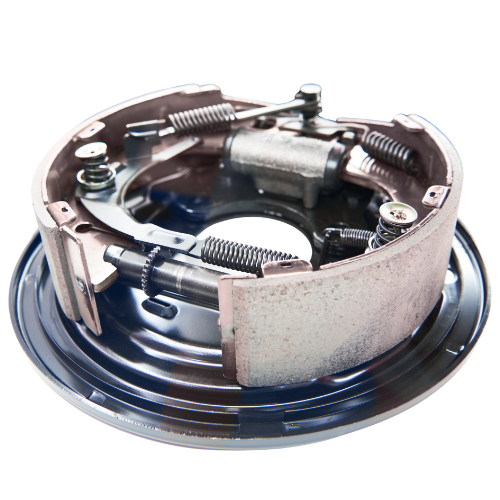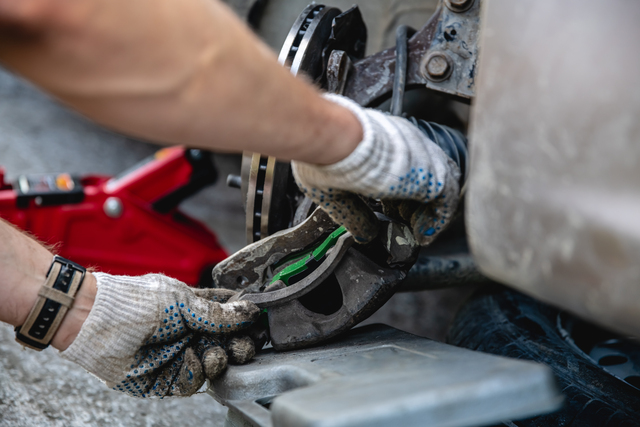Explore the four key components that make up a truck’s brake system—engineered to ensure safe, reliable, and powerful stopping performance on every road.

At the heart of any reliable braking system lies one of its most important components: the brake caliper.
For trucks and trailers equipped with air brakes and disc braking systems, the brake caliper directly impacts how quickly and efficiently the vehicle can come to a stop. This article takes a practical look at how caliper performance influences stopping distance, and why truck owners, fleet operators, and parts buyers should pay close attention to it.

A brake caliper is the part of a disc brake that houses the brake pads and pistons. When the driver applies the brakes, the caliper’s pistons push the pads against the brake disc (or rotor), creating friction that slows down the wheels.
In heavy vehicles, where stopping a fully loaded truck requires significant force, the quality and performance of the brake caliper become especially important.
Stopping distance is the length a vehicle travels from the time the brakes are applied to the moment it comes to a full stop. Here’s how brake calipers affect this critical measure:
1. Clamping Force
The stronger the caliper’s clamping force, the better the braking. High-performance calipers—especially those with multiple pistons—apply a more even and powerful squeeze to the brake rotor. This improves friction between the pad and disc, resulting in shorter stopping distances.
For commercial vehicles, upgrading to better calipers can mean stopping several metres sooner—an advantage that can make a real difference in emergency situations.
2. Heat Dissipation and Fade Resistance
Braking generates a lot of heat, and if the caliper can’t handle it, performance drops. This is known as brake fade. When calipers overheat, they can’t apply consistent pressure, leading to longer stopping distances.
Good calipers are designed with materials and construction that help disperse heat—such as aluminium housings or cooling channels—which helps maintain braking efficiency over longer hauls and in tough conditions.
3. Pad-to-Rotor Contact Quality
Consistent, full contact between the pad and rotor ensures maximum friction. Poor-quality or worn calipers might press unevenly, creating patchy contact and reducing braking power. That slight inconsistency translates directly to longer stops.
Whether it’s a heavy-duty line-haul vehicle or a city-based delivery truck, even pad contact is key for reliable braking every time.
4. Caliper Response Time
Some calipers engage faster than others. This isn’t just about speed—faster engagement reduces the lag between pressing the brake and actual deceleration. High-quality calipers respond quickly and consistently, giving drivers more control and reducing the time it takes to stop.
In fleets that cover long distances, this can mean better overall handling and less brake stress.
5. Caliper Rigidity and Build Quality
When a caliper flexes under pressure, it weakens braking force. High-performance calipers are engineered to resist flexing, even under extreme loads or hard braking. Rigid calipers apply force more efficiently, allowing for shorter, smoother stops.
For trucks carrying heavy or uneven loads, this kind of consistent braking makes a huge difference in control and confidence behind the wheel.
Commercial vehicles often use multi-piston calipers for one reason: better braking power. While single-piston designs are more affordable and common in smaller vehicles, they tend to apply uneven pressure.
Multi-piston calipers (such as 2-, 4- or 6-piston designs) offer more consistent pressure, leading to better wear, improved control, and—most importantly—shorter stopping distances. When combined with quality brake shoes and regular brake chamber maintenance, they form a robust braking system built for safety.

Even top-of-the-line calipers can perform poorly if they aren’t properly maintained. Things like sticking pistons, damaged seals, or corroded slide pins reduce caliper efficiency, which in turn increases stopping distance.
Routine checks should include the caliper’s movement, fluid integrity, and how evenly the pads are wearing. If your brake response feels sluggish or uneven, it’s worth investigating the caliper before it leads to a more serious issue—or a brake chamber replacement down the line.
Brake performance tests show that vehicles equipped with upgraded calipers and modern air brake components often stop 10–20% sooner than those using older or lower-grade parts. That difference could be the space between a near miss and an accident.
While calipers play a central role, they work best when paired with other well-maintained parts. These include:
For any truck driver or fleet manager, understanding how these components work together can make a significant difference in both performance and long-term maintenance costs.
Brake caliper performance plays a major role in how quickly a commercial vehicle can stop—and in a world where every metre counts, that performance matters. From clamping force and heat resistance to response time and build quality, high-functioning calipers from reliable truck part suppliers help reduce wear, improve safety, and give drivers better control on the road.
Whether you’re running a fleet or managing your own truck, now’s a great time to review the condition of your calipers—especially if you’re already replacing components like slack adjusters, brake chambers, or brake shoes. A high-quality, well-maintained brake system doesn’t just stop better—it adds confidence to every drive. If you’re looking to upgrade or replace, explore our range of reliable brake components designed to keep your vehicles performing at their best.
What’s the most common sign of a failing brake caliper?
One common symptom is uneven brake pad wear or pulling to one side when braking. In some cases, you may hear grinding or feel sluggish response.
Can I upgrade to multi-piston calipers on an older truck?
In many cases, yes. It depends on your axle and rotor setup, but upgrades are available for a wide range of commercial vehicles.
Do brake calipers wear out like pads or shoes?
Calipers don’t wear out as often, but they can seize, corrode, or lose responsiveness over time—especially if not maintained.
How often should calipers be inspected?
At least once a year, or during major brake maintenance. If you drive in heavy or demanding conditions, check more often.
Will new brake calipers reduce stopping distance immediately?
If your current calipers are underperforming or worn, replacing them with high-quality units will usually improve stopping time and consistency.